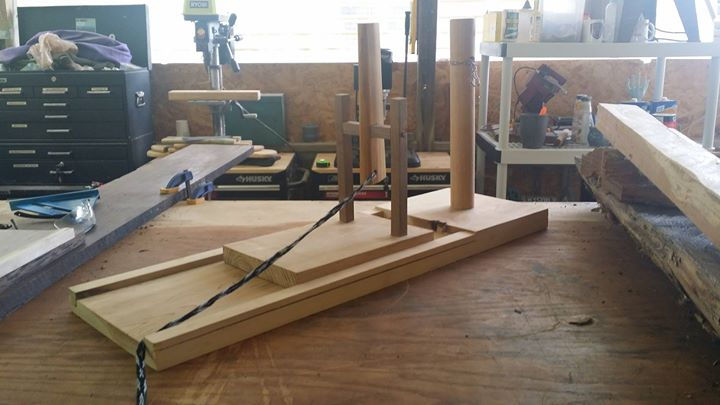Tools for Kute-Uchi, a short history.
- Charles

- Jan 24, 2018
- 3 min read
In reality loop braiding only needs one tool, something to beat the braid into shape. Most cultures used the assistance of a second person to beat the braid; Japan and some Middle Eastern practices, however, did develop tools and techniques that allowed for a single person to braid and beat the braid. Of the known practices that removed a person from the beating process, a fixed or semi-fixed object was placed in front of the braider so that they could pull the braid against the tool.
Here again is where kute-uchi is unique in that Japan developed a mechanical object that moved along the length of the braid called a foot-beater. There were two foot-beaters developed, the heshiki and later the ashiuchidai.
The basic function of the foot-beater is to beat the braid by pulling on a cord with one’s foot that activates a beating sword, release the tension and the sword falls back out of the way of the braid. As the sword beats the braid, the foot beater is pushed back towards the braider incrementally, allowing the beating sword to remain close to where all the threads join.
A heshiki consists of a sled with uprights that hold the beating sword on a pivot point. Some images show heshiki with a built-in anchor point and others with an external anchor point. I suspect that images with built-in anchors are a matter of artistic license to condense the image as the braid would only be able to build for an inch or two before needing to be wound on the anchor. Using a heshiki requires practice to keep the base from rotating to the left or right out of alignment with the braid. The advantage here is that the braider does not have to move and the braid does not require winding, completely removing the need of a second person.
The ashiuchidai takes the heshiki and places it on a base with sides to keep it in line with the braid and includes an incorporated anchor. The reason the ashiuchidai works is because the sled can move away from the anchor, unlike heshiki with integrated anchors. The ashiuchidai, though easier to keep the sled inline, requires a second person to wind the braid on the anchor and reset the sled back to the beginning of the base with the braider moving forward (or the second person moves the base to the braider) and take up the slack on the cord. This is only a disadvantage if the desired finish length of braid is longer than the base. And based on the rough scale of images, a braider can make nearly two feet of braid before needing to wind up the braid using an ashiuchidai.
It's difficult to pinpoint the origin of the heshiki; there are no known surviving beaters, and the earliest images come from 15th Century paintings. Physical specimens of loop braided braids in Japan date back to the 5th Century. This is one of those times where it can’t be proven, but conjecture makes sense, in that foot-beaters existed before the first images based on the increased complexity Japanese braids experienced between the Nara period and the Heian period. Just as the heshiki’s origin date can’t be pinpointed, neither can the ashiuchidai. Images of the ashiuchidai don’t appear until just before the Edo period, and most of the known images are from just past the beginning of the Edo period. Due to the difficulty of using the heshiki, it’s probable that the ashiuchidai was developed earlier than images can prove.
But just like so much of what we currently know about kute-uchi, it's difficult to even guess how much older these foot-beaters are then the paintings prove. And as is with so much of kute-uchi, more research is needed.
My first prototype of an ashiuchidai.

Comments